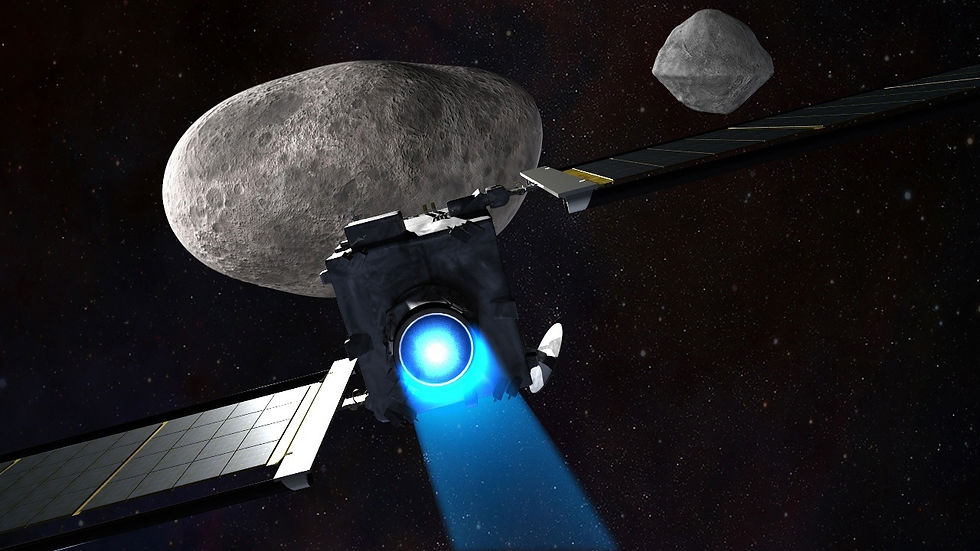NASA’s DART Mission to strike Asteroid tonight in historic planetary defense test
- Karthik Naren
- Sep 26, 2022
- 3 min read
DART is a spacecraft designed to impact an asteroid as a test of the technology. DART’s target asteroid is NOT a threat to Earth. This asteroid system is a perfect testing ground to see if intentionally crashing a spacecraft into an asteroid is an effective way to change its course, should an Earth-threatening asteroid be discovered in the future.

NASA's Double Asteroid Redirection Test (DART) spacecraft is hurtling toward the asteroid Didymos and its moonlet Dimorphos, and it'll reach its target tonight (Sept. 26). At 7:14 p.m. EDT (2314 GMT), if all goes well, DART will crash into Dimorphos in an attempt to alter the moonlet's trajectory. The mission is meant to test the theory that this technique could be used to divert an asteroid heading straight for Earth.

The NASA Double Asteroid Redirection Test (DART) launched atop a SpaceX Falcon 9 rocket on Nov. 23, 2021, and has since been traveling the 7 million miles (11 million kilometers) to Didymos System, It will be the first planetary defense mission and will demonstrate asteroid deflection by kinetic impact. DART will impact the secondary member of the [65803] Didymos binary asteroid system in order to modify the trajectory of the moon through momentum transfer. DART is part of the Asteroid Impact & Deflection Assessment (AIDA) international cooperation along with the ESA Hera mission study. DART is the first hypervelocity impact experiment on an asteroid at a realistic scale relevant to planetary defense, where the impact conditions and the projectile properties are fully known.

The impact of the 650 kg DART spacecraft at 6.65 km/s on the 160-m Didymos moon will change the binary orbital period by ~10 minutes (more than a 1% change) assuming momentum transfer efficiency β=1. This change will be measured by supporting Earth-based optical and radar observations, since Didymos in September-October, 2022 approaches within 0.075 AU from Earth. Ground-based optical observations of the Didymos light curve will measure the period change via the timing of mutual events, while radar will observe the orbital motions. These measurements determine the orbital velocity change from the DART impact.
"This is an exciting time, not only for the agency but in space history and in the history of humankind, quite frankly," Lindley Johnson, NASA's planetary defense officer, said in a news conference held on Thursday (Sept. 22). "This demonstration is extremely important to our future here on Earth."

"Dimorphos is a tiny asteroid," Tom Statler, the mission's program scientist at NASA, said during the news conference. "We've never seen it up close, we don't know what it looks like, we don't know what the shape is. And that's just one of the things that leads to the technical challenges of DART. Hitting an asteroid is a tough thing to do."
Elena Adams, DART mission systems engineer at JHUAPL, said that DRACO won't even spot Dimorphos until about an hour before impact, at which point it'll be just one pixel in DRACO's field of view. "At three minutes prior to impact, two minutes prior to impact, it is 42 pixels in size," Adams said during the news conference.
LICIACube Contribution
The LICIACube mass is about 13 kg: it is developed by Argotec and equipped with two different payloads named LEIA and LUKE.
LEIA (Liciacube Explorer Imaging for Asteroid) is a narrow FoV camera able to acquire images with a spatial scale close to 1.4 m/px at the minimum distance of about 55 km, while LUKE (Liciacube Unit Key Explorer) is a wide FoV imager with an RGB Bayer pattern filter.
LEIA and LUKE will offer the opportunity to obtain a unique science return, investigating for the first time the nature of a binary NEA. Comparing the impact and non-impact regions, as well as studying the nature and the evolution of the produced dust plume, will allow us to deeply investigate the composition and the structure of the material composing a small double NEA.

The structure and evolution of the DART impact ejecta will be studied by the LICIACube spacecraft which is the ASI contribution to DART. LICIACube will be carried by DART close to Didymos and released two or more days prior to the impact, to perform a separate flyby of Didymos with closest approach several minutes after the DART impact. It will obtain images of the impact ejecta and their evolution, the DART impact site if the ejecta plume is sufficiently transparent, and the non-impact hemisphere of the target asteroid.
The LICIACube observations of the DART ejecta plume make an important contribution to the determination of momentum transfer from the DART impact, by providing information on the ejecta plume momentum and particularly its direction relative to the DART approach vector.

LICIACube launched with DART, hosted as a piggyback, and released from Impactor spacecraft on September 11, 2022, 10 days before the Event.
DART impact and autonomously guided along its fly-by trajectory. The aim of this
mission is to testify the DART impact and obtain multiple images of the ejecta plume, of the impact site and of the nonimpact hemisphere.







Comments